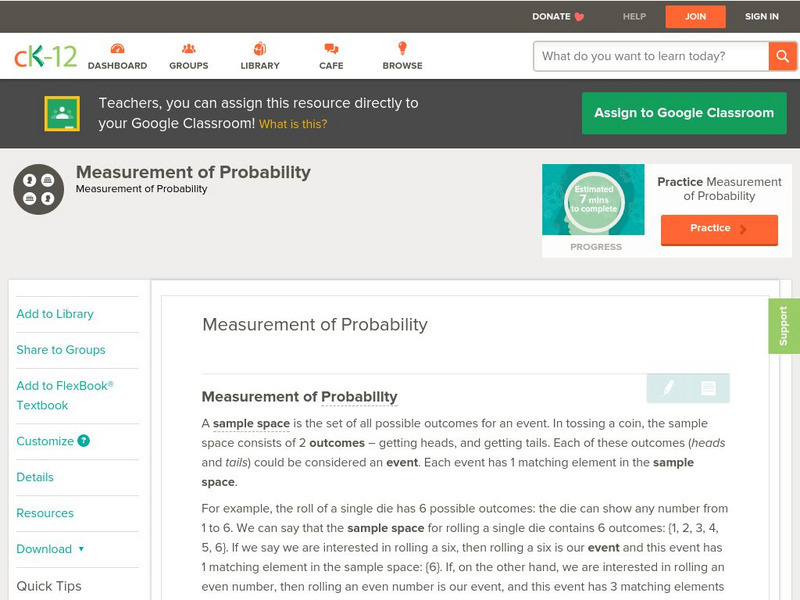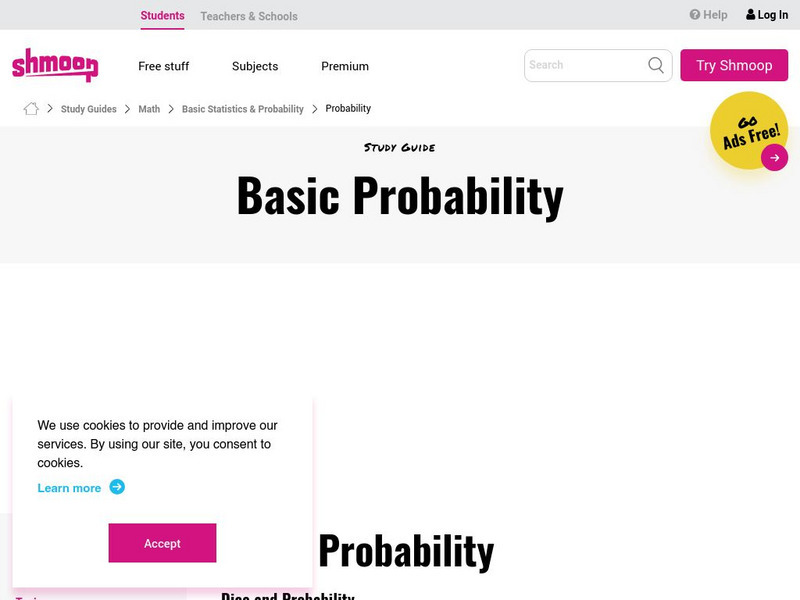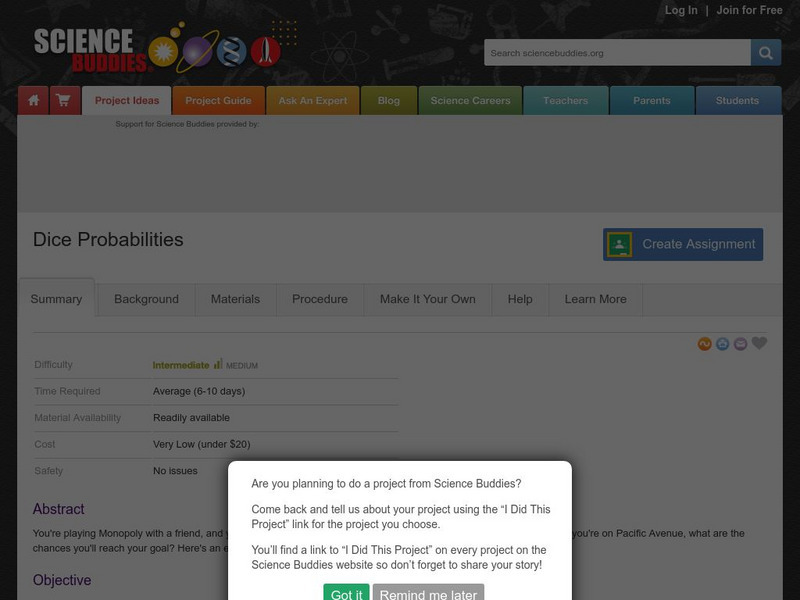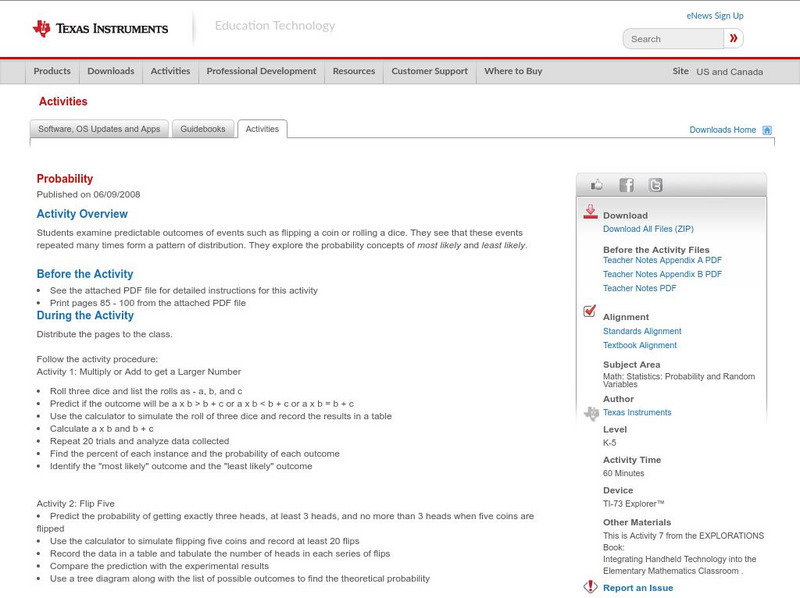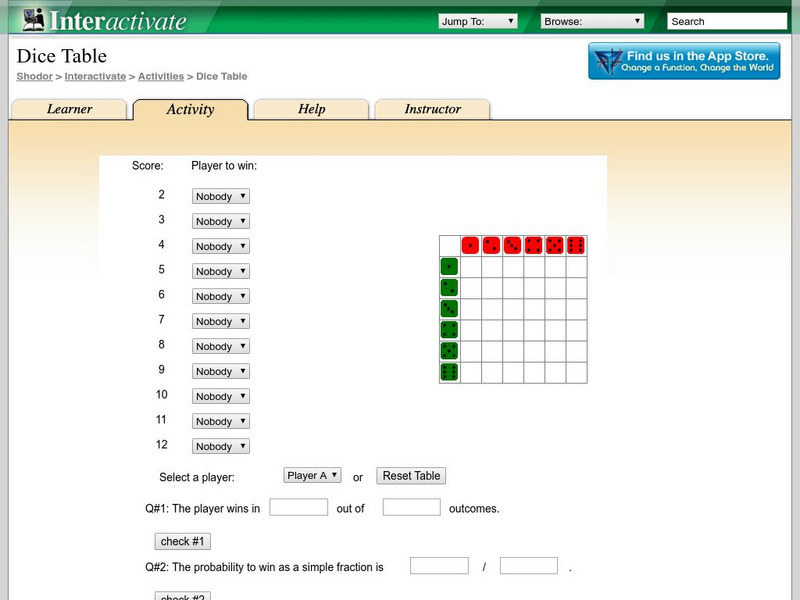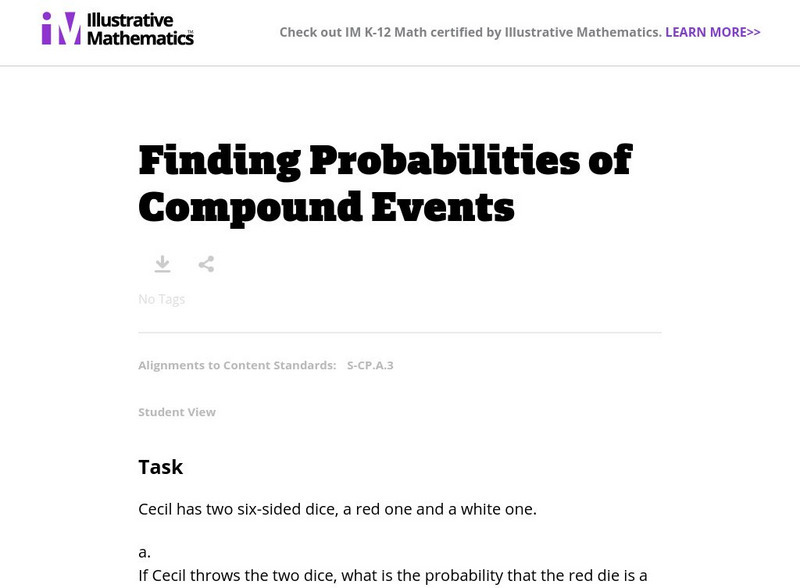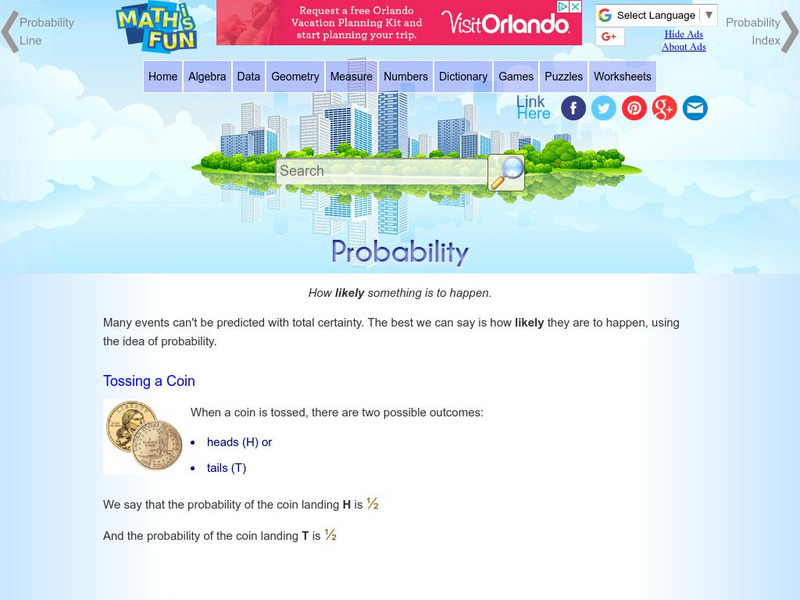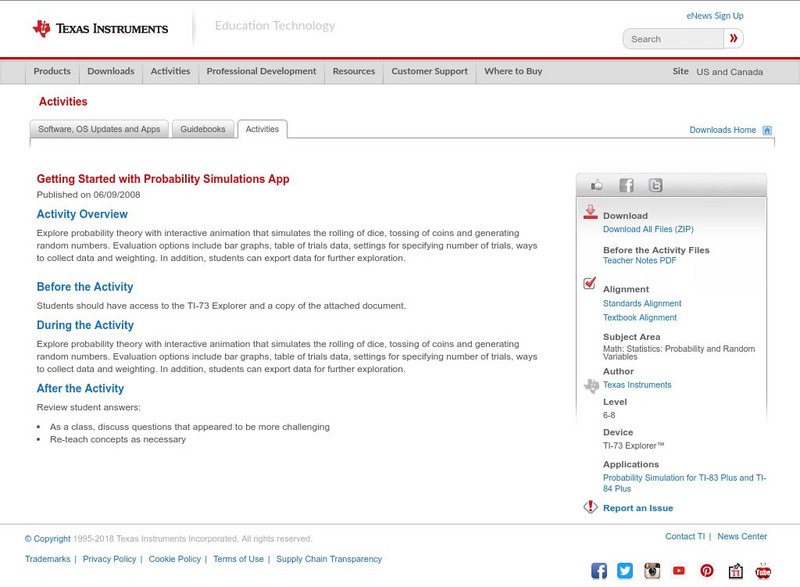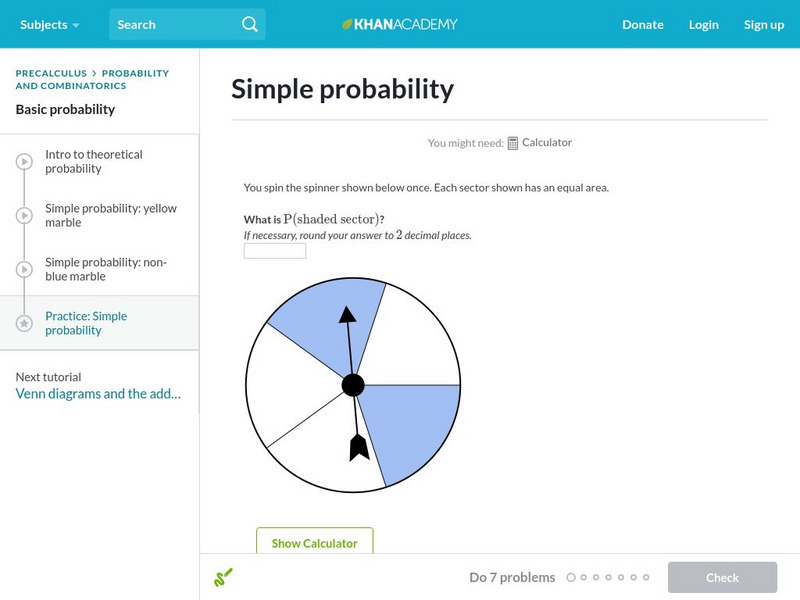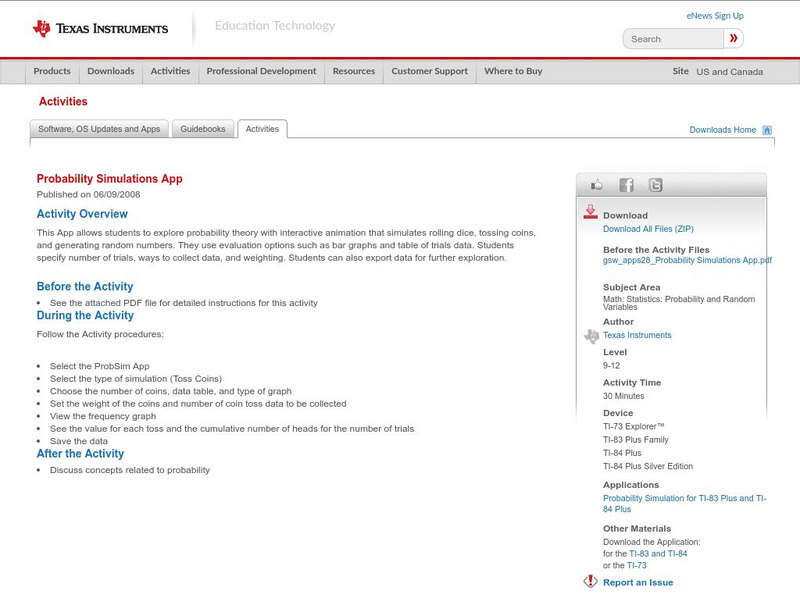Hi, what do you want to do?
Beacon Learning Center
Beacon Learning Center: Lions, Tigers, and Probability
Students explore the probabilities of simple events, such as rolling a dice, in this interactive web lesson.
CK-12 Foundation
Ck 12: Algebra Ii: 5.1 Sample Spaces and Probability
This section explores how to determine the sample space, or possible outcomes, for an event such as rolling dice. It also investigates how to determine the probability of different outcomes occurring for an activity such as flipping a...
SMART Technologies
Smart: Dice and Card Math Games
Kids love dice and playing with decks of cards. Leverage these two great (and inexpensive tools) to help students work on math facts, place value and more.
PBS
Pbs Mathline: Remove One Lesson Plan [Pdf]
Students play a game involving chips, dice, and a number line to explore the outcomes of events. Printable lesson.
CK-12 Foundation
Ck 12: Probability: Measurement of Probability Grades 9 10
[Free Registration/Login may be required to access all resource tools.] Find the number of outcomes, theoretical probability, and odds of events involving coins, dice, and cards.
Shodor Education Foundation
Shodor Interactivate: Racing Game With Two Dice
Simulate a game where "N" players roll two dice, and the lucky player has an advantage for reaching the finish.
ClassFlow
Class Flow: Dice and Probability
[Free Registration/Login Required] This flipchart is designed to explore the probability of rolling certain values using the dice tool. By the end of this lesson, the students will have gathered experimental data, made hypothesis about...
Shmoop University
Shmoop: Basic Statistics & Probability: Basic Probability
The mathematics resource investigates basic probability. Students learn about the topic through notes and examples. The tutorial consists of practice exercises to check for comprehension of the concept.
TED Talks
Ted: Ted Ed: The Last Banana: A Thought Experiment in Probability
Imagine a game played with two players and two dice: if the biggest number rolled is one, two, three, or four, player 1 wins. If the biggest number rolled is five or six, player 2 wins. Who has the best probability of winning the game?...
University of Texas at Austin
Mathematics Teks Toolkit: Rolling Races
Students play a game by rolling dice and determining the probability of outcomes of colors.
Khan Academy
Khan Academy: Theoretical and Experimental Probability: Coin Flips and Die Rolls
A set of questions on experimental and theoretical probabilities using coins and dice. Answers are accompanied by explanations.
Science Buddies
Science Buddies: Dice Probabilities
You're playing Monopoly with a friend, and you've already got Park Place and you really, really want to get Boardwalk. If you're on Pacific Avenue, what are the chances you'll reach your goal? Here's an easy project that will show you...
Texas Instruments
Texas Instruments: Probability
Students examine predictable outcomes of events such as flipping a coin or rolling a dice. They see that these events repeated many times form a pattern of distribution. They explore the probability concepts of most likely and least likely.
Shodor Education Foundation
Shodor Interactivate: Dice Table
A dice-table activity introduces students to probability and to converting probability to a simple fraction, a decimal, and a percentage.
Illustrative Mathematics
Illustrative Mathematics: 7.sp Rolling Dice
Roll two dice 10 times. After each roll, note whether any sixes were observed and record your results in the table below. Aligns with 7.SP.C.7.
Illustrative Mathematics
Illustrative Mathematics: S cp.a.3: Finding Probabilities of Compound Events
Cecil has two six-sided dice, a red one and a white one. Aligns with S-CP.A.3.
Shodor Education Foundation
Shodor Interactivate: Experimental Probability
This interactive learning activity allows students to explore experimental probability using spinners and dice. Teacher resources are included.
Math Is Fun
Math Is Fun: Probability
Explains what probability and outcomes are. Presents a formula for calculating probability for a simple dice or marble experiment. Introduces the concept of a probability line and discusses vocabulary used to talk about probability....
Mathigon
Mathigon: Probability and Discrete Math: Predicting the Future
This lesson focuses on probability theory for predicting the outcome of flipping a coin, and then flipping it multiple times.
Illustrative Mathematics
Illustrative Mathematics: 7.sp.8 Tetrahedral Dice
Many games use dice which are six-sided and fair (meaning each face on the die is equally likely to land face up). Many games also use the sum of two dice rolled at the same time to determine movement of game pieces. However, not all...
Texas Instruments
Texas Instruments: Getting Started With Probability Simulations App
Explore probability theory with interactive animation that simulates the rolling of dice, tossing of coins and generating random numbers. Evaluation options include bar graphs, table of trials data, settings for specifying the number of...
Khan Academy
Khan Academy: Simple Probability
Practice finding probabilities of events, such as rolling dice, drawing marbles out of a bag, and spinning spinners. Students receive immediate feedback and have the opportunity to try questions repeatedly, watch a video or receive hints.
Texas Instruments
Texas Instruments: Probability Simulations App
This App allows students to explore probability theory with interactive animation that simulates rolling dice, tossing coins, and generating random numbers. They use evaluation options such as bar graphs and table of trials data....
National Council of Teachers of Mathematics
Nctm: Figure This: Are Dice Fair or Not?
Is it fair or not fair? That is the question. Try this math challenge where you use your probability and number sense skills to determine whether or not a game is fair. Find out how mastering this challenge can be useful in real life...
Other popular searches
- Probability and Dice
- Probability and Dice Graph
- Probability Dice and Cards
- Probability Dice and Coin







